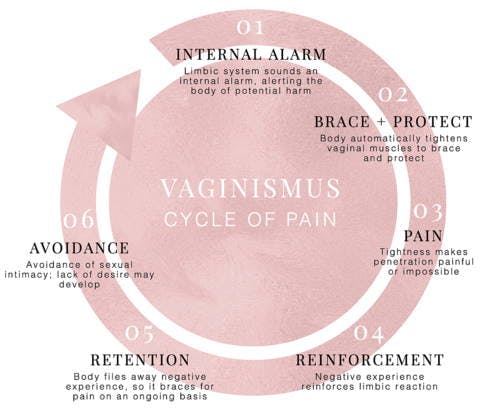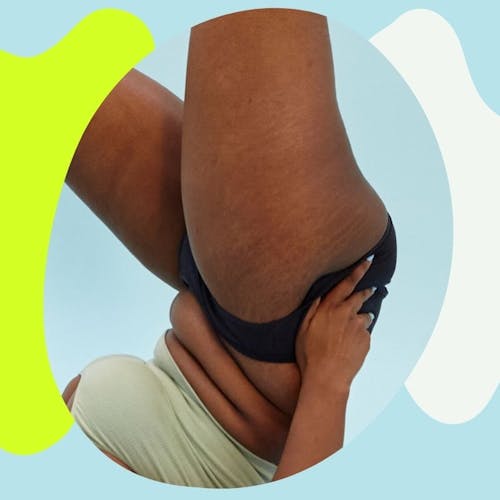This website uses cookies to enhance the user experience. By using Yoppie you are agreeing to our use of cookies.
A Tell-All Guide To Vaginismus
Written by Yoppie
29 Jul 2020
What is Vaginismus? 🧐
What causes it? 👀
What does it feel like? 😯
What about using tampons? 🩸
Can you just… leave it alone? 🤷♀️
The vagina can be rather mysterious sometimes, but Vaginismus may be the biggest enigma of them all. If you’ve never heard of this condition, that’s because it is rarely discussed. We think it’s time to be a little more loose-lipped about it - pardon the pun! Luckily, our favourite Netflix TV show ‘Sex Education’ delves into the topic in their most recent series, with one character describing her experience; “It’s like my vagina has lockjaw”.
Although it’s uncommon, some people do experience vaginismus, whether a temporary spell or a permanent affliction. Let’s find out more.
What is Vaginismus? 🧐
Good question! Vaginismus is a condition in which the muscles in and around the vagina tighten up when you try to insert something (think penis or tampon). It can be mildly painful or even very painful for some women, not to mention emotionally frustrating, since they often have absolutely no control over it. This tightening can happen when a sexual partner attempts penetration, when inserting a tampon, or even when touched near the vagina. (1)
There are two types; primary vaginismus, where penetration has never been achieved, and secondary vaginismus, where penetration was achieved before, but is no longer possible.
What causes it? 👀
When examined, women typically show no signs of anything being wrong, or any reason for the muscles to contract, making it difficult to diagnose. Many believe vaginismus is the body's reaction to a fear of penetration, whether or not that fear is conscious. There can be physical and emotional causes, with some examples of physical causes being:
- Medical conditions like STIs (sexually transmitted infections), a UTI (urinary tract infection) or endometriosis
- Trauma from childbirth
- Menopause
- Pelvic injuries
- Physical/sexual abuse
- Medications
Emotional causes include:
- Fear of intercourse (pain or intimacy)
- Anxiety or stress Partner issues
- Childhood trauma
- Growing up with strong religious views on sex
The below diagram from Vaginismus.com shows how the body’s inherent fear of penetration can cause a cyclical reaction which is difficult to break.

What does it feel like? 😯
As with many female health issues it is sometimes difficult to get the correct diagnosis for vaginismus straight away, leaving you with months or even years of frustration.
While symptoms vary from woman to woman, the ones to watch out for are:
- Painful intercourse (dyspareunia) - a tightness or pain that can feel like burning/stinging, with pain ranging from mild to severe
- Difficulty achieving penetration (or it is downright impossible!)
- Pain while trying to insert a tampon or during vaginal examinations (i.e. a smear test)
- Muscle spasms or breathing cessation while trying to attempt penetration
What about using tampons? 🩸
Using tampons can be tricky with vaginismus, but there are a few things you can try to make things easier, like using the smallest size of tampon (even if you have a heavy flow) and insert them using an applicator (there are some reusable, eco-friendly ones on the market), with a small amount of water-based lubricant to make insertion smoother and easier. If your tampon feels like it’s hitting a wall, you may wish to stick to sanitary pads instead.
What treatment is available? 🩺
If you choose to try treatment for vaginismus, it’s always best to go speak to your doctor about options, but if you don’t feel comfortable doing this, there are some things you can try from the comfort of home.
There are many services you could be referred to for help including psychologists if you have anxiety, traumatic experiences, phobias or relationship problems. Some women may need referral to specialists such as gynaecologists, sexual therapists, psychiatrists, or psychotherapists.
Ideas you can practice from home include:
- Practice relaxing your pelvic floor with Kegel exercises to contract and relax muscles
- Learn more about the vaginal anatomy, to understand how your sexual response cycle works and where the pain is coming from
- Emotional exercises can help to identify and work towards resolving any emotional factors that are contributing to the condition
- Reduce sensitivity to insertion by practicing touching the vaginal opening every day without causing any pain, moving closer day by day until you can eventually touch the vagina and insert a finger. This method is a bit like exposure therapy
One of the most beneficial ways to identify the triggers for vaginismus and personalise your treatment is through physical therapy with a pelvic floor physiotherapist who can help teach you deep relaxation techniques, and assist in the use of vaginal dilators if you struggle to use them. Vaginal dilators are one of the most successful treatments for Vaginismus. These look like a selection of cone-shaped silicone inserts that allow you to attempt penetration in your own time, at your own pace. The dilators get progressively larger, allowing you to stretch the vaginal muscles and train them to become more flexible.
Some studies have shown that a combination of the above treatment has proven effective, so it depends entirely on the individual.
Can you just… leave it alone? 🤷♀️
Yes! Vaginismus manifests differently for each woman, which is why everyone has a different method of dealing with it. Some women don’t attempt to change their vaginismus, choosing instead to embrace this unique feature and let it be. Vaginismus does not interfere with your ability to feel sexually aroused, so acts of foreplay - like oral sex and massage - can prove just as satisfying as intercourse.
Talking about the condition and options with your partner can often be cathartic, and better in the long term than the worry of hiding it. If, however, you would prefer to seek treatment, speak to your GP so they can recommend the next steps based on your individual case.
Do you have vaginismus? This condition is rarely discussed, so we’d love to hear your experiences! Let us know over on Instagram @itsyoppie. Don't forget that our personalised period subscription box can get menstrual care delivered easily and regularly through your letterbox, including our super-soft organic pads and liners. That's one less thing to worry about!
Additional References:
Crowley T, Goldmeier D, Hiller J. Diagnosing and managing vaginismus. BMJ (Online) 2009; 339: 225–229.
Melnik T, Hawton K, McGuire H. Interventions for vaginismus. Cochrane Database Syst Rev. Epub ahead of print 12 December 2012. DOI: 10.1002/14651858.cd001760.pub2.
Fact checked by Doctor Brooke Vandermolen.
Section jump
Back to top
Subscribe To Our Newsletter
YOPPIE





© 2026 Yoppie is a registered trademark of Phlo Technologies Ltd.
Yoppie's supplements are not a substitute for a varied diet and healthy lifestyle and are not intended to diagnose, treat, or cure any disease. If you are pregnant, breastfeeding, have a medical condition or are under medical supervision, please consult with your doctor before taking any of our products.






